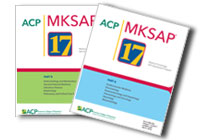 MKSAP has been trusted by internists since 1967 as the best resource for updating knowledge. MKSAP 17, available in Complete, Digital, and Print packages, consists of 11 comprehensive text chapters with related multiple-choice questions. You'll find 1,200 completely new questions to help you identify learning gaps, stay current, and gain the knowledge you need to provide the best possible patient care. MKSAP 17's original and high-quality questions evolve out of case studies and patient scenarios based on the latest evidence.
MKSAP has been trusted by internists since 1967 as the best resource for updating knowledge. MKSAP 17, available in Complete, Digital, and Print packages, consists of 11 comprehensive text chapters with related multiple-choice questions. You'll find 1,200 completely new questions to help you identify learning gaps, stay current, and gain the knowledge you need to provide the best possible patient care. MKSAP 17's original and high-quality questions evolve out of case studies and patient scenarios based on the latest evidence.
For more information on MKSAP 17, or to order your copy, visit mksap17.acponline.org.
MKSAP 17 Q & A
A 62-year-old woman is evaluated for a 4-hour episode of dizziness. Upon arising from bed in the morning, she noted the abrupt onset of a spinning sensation and imbalance. She has moderate nausea but no vomiting. Symptoms are markedly accentuated when she positions her head backward or forward, such as when bending down to tie her shoe. She reports no dysarthria, diplopia, dysphagia, weakness, numbness, tinnitus, headache, recent head trauma, otalgia, or recent upper respiratory tract infection. She had a similar episode several years ago. Medical history is remarkable for osteoporosis. Her medications are alendronate, calcium, and vitamin D.
On physical examination, the patient is afebrile, blood pressure is 137/84 mm Hg and pulse rate is 78/min without orthostasis, and respiration rate is 13/min. BMI is 25. Tympanic membranes, external auditory canals, and gross auditory acuity are normal. Cardiopulmonary and neurologic examinations are normal. The Dix-Hallpike maneuver results in mild vertigo with nausea, and after 10 seconds, there are five beats of upbeat nystagmus with a rotatory component with the upper pole of the eyes beating toward the lower ear. The nystagmus lasts for 10 seconds and then abates.
Which of the following is the most likely diagnosis?
A: Diazepam
B: Epley maneuver
C: Meclizine
D: Vestibular rehabilitation therapy
Click here for the answer and critique.
Back to the November International Newsletter

